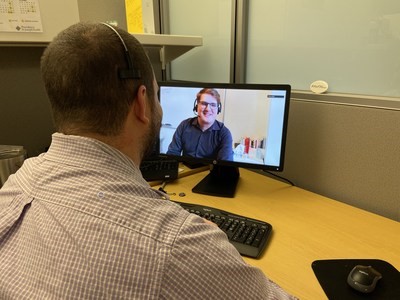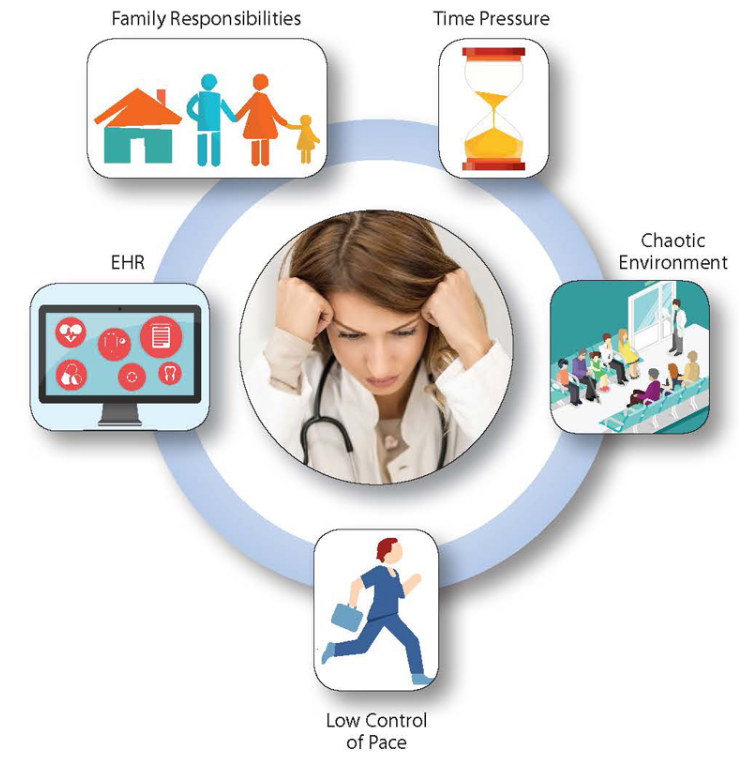Healthcare Looks to Telehealth to Address Physician Burnout, Stress
In an industry plagued by burnout, hospitals and health systems are using telehealth to give providers virtual access to mental health counselors - and to make their jobs less stressful.
Like any profession that deals in life and death, healthcare has a stress and burnout problem - to which telehealth could be the answer.
Physicians have the highest suicide rate of any profession, losing 300 to 400 of their colleagues a year, and their struggles with stress and depression have an adverse effect on the healthcare industry’s economic health – a 2019 study posted in the Annals of Internal Medicine found that burnout adds roughly $4.6 billion in costs each year.
Writing in the American Journal of Medicine, Scott Yates, MD, MBA, MS, FACP, of the Plano, Texas-based Center for Executive Medicine, says burnout affects roughly half of all physicians in practice, manifesting itself in medical errors, lower quality of care and higher costs. Furthermore, it’s a systemic issue, rather than an individual one, and COVID-19 certainly isn’t helping.
At a time when the coronavirus pandemic is putting extra pressure on care providers to reduce in-person visits, hospitals and health systems are launching telehealth platforms to put doctors and nurses in front of mental health support at the time and place – and on the device – of their choice. And they’re looking to telehealth to reduce the burden on providers by automating many of the tasks that are causing stress in the first place.
“The appeal of telemedicine isn’t just that it makes things easier (though it certainly can),” Adrian Rawlinson, MD, a California-based sports medicine specialist, explained in a column on physician burnout for the online journal Medium. “Telemedicine is a unique and necessary new approach to healthcare that allows providers the freedom to administer the care that works best for both them and for their patients, and it gives patients greater flexibility in managing their health.”
Using Telehealth to Help Providers in Peril
Although the COVID-19 pandemic cast the spotlight on provider stress and burnout, the issue has been around long before the virus appeared. And networks like Providence Health have already taken steps to address it.
The Washington-based health system, with more than 50 hospitals in eight states, rolled out its Telebehavioral Health Concierge program in January 2020, offering virtual care visits with a counselor within two days. They’ve since renamed it the Behavioral Health Concierge program and expanded its reach to include caregivers and family members in Oregon, California and Montana.
“We wanted to build something dedicated to caregivers,” says Josh Cutler, a licensed clinical social worker who helped launched the service. “Before and especially during (COVID-19), we have been at the center of an epidemic of burnout and suicide in healthcare. We needed to give (providers) something that would address that on their terms.”

Arpan Waghray, MD, a psychiatrist and chair of the health system’s behavioral medicine clinical practice group who joined Cutler in developing the program, says the platform not only connects with people in crisis, but can be used to provide health and wellness resources that help providers before they reach that crisis stage.
“You automatically equate mental health with mental illness, as opposed to mental health and wellness,” he says. “With this program, our goal was to move upstream and meet people where they are.”
That points to one of the strengths of an online program: Giving users the resources they need and the freedom to access what they need at their own pace. For those who don’t feel comfortable talking to someone else about their problems, a self-serve platform might be more effective.
“It’s very consumer-centric to do this, but it’s not very provider-centric,” Waghray says. “In some ways we have to adjust our thinking.”
Cutler notes that doctors and nurses are trained to give care, but often aren’t sure how or when to seek it themselves. They’re either uncertain of how to access help or embarrassed about needing it.
A telehealth platform makes it easier to find help, he says, and gives them the opportunity to connect discretely at the time and place of their choice.
“I can talk to people who are sitting at home or in their parked car,” he says. “It’s all about giving them the space to talk, and establishing that connection.”
Technology as the Cause and Solution?
While health systems and hospitals are using connected health platforms to connect stressed out staff with counselors, they’re also touting the value of telehealth in reducing stress. And that benefit has been around since well before COVID-19.
The American Telemedicine Association made physician well-being and stress reduction a cornerstone of its 2019 conference and exhibition in New Orleans. The effort was spearheaded by Peter Yellowlees, MD, a professor of psychiatry at the University of California at Davis and Chief Wellness Officer at UC Davis Health.
The kicker? At that time, the industry was looking at stress as a by-product of dealing with new technology, particularly electronic medical records platforms.
“We have not worked well with technology in the past,” Yellowlees said. “We’re actually causing poor care with the way we use technology,” he says. “We have to understand how to use it better.”

“The main issue is documentation,” he said, pointing out that American doctors spend three times as much time documenting as do their counterparts in Australia and Europe.
But while older technology platforms – including telemedicine – may have been cumbersome, newer versions are smaller and more portable. Whereas providers once had to go to the technology, such as a nurse’s station or a computer in the office, they can now bring the technology with them as they make their rounds.
“The beauty nowadays is we’re freed up to do more of what we want to do,” he said.
The same applies to seeing patients. Providers who once had to jump through several different hoops to set up a telehealth visit can now connect with a patient on a laptop or smartphone from the comfort of their own homes. They can set schedules that fit better into their daily lives, setting aside time for family and for seeing patients.
“It actually is a much more egalitarian relationship,” says Yellowlees, who uses a telemedicine platform to see patients at home “Patients feel like this is a much more normal interaction.”
A connected care platform can also foster collaboration and teamwork, a cornerstone of the industry’s move toward value-based care and the patient-centered medical home. Through telemedicine, doctors and nurses can collaborate with each other, and with specialists, reducing stress on one provider and enabling different providers to handle the tasks more suited to them.
“Healthcare is increasingly a team game,” says Yellowlees. “The future (of the industry) lies in virtual care, and virtual care teams.”
How Telehealth Improves the Work-Life Balance
Aside from improving patient care and reducing costs, a selling point for the adoption of telemedicine technology has always been that it can help improve clinician workflows by reducing administrative tasks and giving them access to clinical decision support. This, in turn, allows the clinician to practice at the top of his or her license and focus on the patient.
One such example can be found in teleneurology.
Keith J. McAvoy, MD, the medical director of teleneurology for New Hampshire’s Dartmouth-Hitchcock Medical Center in Manchester, says a telemedicine platform that links neurologists at a central site, like Dartmouth-Hitchcock, to smaller hospitals across the region can reduce stress on doctors and nurses in those rural hospitals who have to transfer critically injured patients to a larger facility because they don’t have the skills or resources to treat on-site.
“Healthcare is increasingly a team game. The future (of the industry) lies in virtual care, and virtual care teams.”
“There are many of our spoke hospitals that have no neurology coverage at all, so we provide that neurology coverage,” he said of a network that provides on-demand services to close to a dozen locations in New Hampshire, Vermont and Maine, to a tune of roughly 800 consults a year.
McAvoy, speaking at a recent virtual conference coordinated by the Northeast Telehealth Resource Center and the Mid-Atlantic Telehealth Resource Center, said a telehealth platform gives providers in those spoke hospitals the resources and support they need to treat more patients, and it helps to reduce self-doubt and feelings of isolation.
The platform also gives neurologists more of an opportunity to expand their horizons and treat more patients – not only by administering emergency care to those suffering a stroke, but in offering specialist consults and follow-up services to any number of rural and remote locations.
That’s an often-overlooked benefit for a specialty that ranks in the top 5 in burnouts.
They “address many conditions without a known cure,” he said, which is often stressful. “Telling a patient that they don’t have a neurologic condition,” he added, is often the best part of being a neurologist.

Telehealth “has the potential for providing more dedicated and consistent care,” McAvoy says, which in turn improves outcomes for patients and perks up the providers.
“A happy neurologist means better care for the patients,” he added.
Another example can be found in eConsults.
With the COVID-19 crisis expanding the ranks of the unemployed and pushing more and more people off their insurance plans, community health clinics, federally qualified health centers and rural health clinics all expect to see a surge in business. This puts pressure on clinic staff who already have a lot on their plates.
Expanded telehealth coverage for FQHCs and RHCs is one of the cornerstones of a legislative plan to continue telehealth’s momentum beyond the coronavirus. This would allow these providers to, among other things, use telehealth channels to seek specialist consults and support.
That’s what the MAVEN Project does. Launched in 2014, this Massachusetts-based group provides mentoring and consults to health clinics in high-stress, low-resource environments. Their services are free of charge, and their support group is comprised of retired and semi-retired physicians who want to give back to their profession.
“What we have are a group of physicians who are truly best in class, and want to share their skills with others.”
“They offer a wealth of knowledge and expertise and decades and decades of clinical experience,” Lisa Bard Levine, MD, MBA, the organization’s CEO, told mHealthIntelligence in 2018. “What we have are a group of physicians who are truly best in class, and want to share their skills with others.”
One of the guiding principles of the MAVEN Project is to help harried providers who need some advice or support.
“We’re here to give these providers support that’s really needed,” Levine says. “A lot of these primary care providers are newly trained, or working for clinics that struggle to provide necessary support for their physicians. A lot of them are realizing that this is a gray area in healthcare.”
Making Telehealth the Rule, Rather Than the Exception
While health systems like Providence Health create virtual care programs to care for the caregivers, telehealth advocates say the advances in telehealth coverage brought on by the COVID-19 crisis will, in the long run, reduce provider stress.
While the Centers for Medicare & Medicaid Services has released a proposed 2021 Physician Pay Schedule that increases coverage for certain services, Congress is dealing with dozens of bills – and pressure from a large lobbying group – that aim to make permanent many of the telehealth freedoms enacted during the ongoing public health emergency.
The hope among many is that using telehealth and mHealth tools will become second nature for care providers, resulting in improved workloads, reduced stress and a better work-life balance. And while using those tools to help their patients, they’ll also make us of them to help themselves when and where necessary.
“When it’s going right, all the technology disappears, and we have this connection,” says Cutler, at Providence Health, whose work has helped dozens – if not hundreds – of care providers address their health struggles. “This has been some of the most meaningful clinical work that I have done.”





